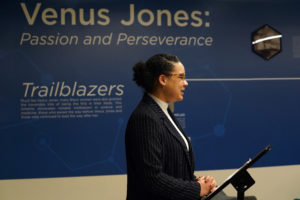Dr. Venus Romance Jones. It’s no wonder University of Mary Washington senior Timbila Kabre said she had “fallen in love” while researching the late physician bearing that name, who in 1968, became the first African-American woman to graduate from Mary Washington.

“Dr. Jones’ hard work, passion and love for others … is absolutely inspiring,” she said at the unveiling of a new mural honoring Jones – which Kabre and her classmates helped design – in UMW’s Jepson Science Center. Mary Washington students, faculty, staff, alums, administrators, President Troy Paino, Board of Visitors members, and Jones’ friends and family gathered together last Friday to dedicate the long-awaited exhibit. The mural’s timeline, and an accompanying digital site, traces Jones’ life and barrier-breaking career as a neurologist, along with other trailblazing Black women in medicine.
The project advances UMW’s initiative to create a more inclusive environment, said Professor of Biological Sciences Andrew Dolby, who spearheaded the effort. Disciplines across the University – visual arts, public and digital history, and the sciences – worked in collaboration, he said, getting input from the Campus Environment Committee and the Jones family.
“This is exactly what we talk about in terms of preparing our students with experiential learning opportunities for the 21st century,” Paino said in his remarks. “Your work will live on in our community, just like Dr. Jones’ legacy.”
Jones came to Mary Washington in 1965, after initially being denied admission at the University of Virginia, where she would later attend medical school. One of five Black students on campus, she excelled academically, earning a bachelor’s degree in chemistry in just three years. She became the chief of neurology at Andrews Air Force Base, volunteering in her community and on medical missions to Haiti in her free time. Tragically, she died in 2001, when a brain aneurysm caused a fatal car crash.
UMW considered ways to best honor Jones, including selecting her as a finalist for the renaming of Trinkle Hall in 2020. When civil rights icon and late professor James Farmer was chosen instead, Dolby began a quest to ensure Jones was properly recognized at Mary Washington, specifically in the Jepson Science Center.
He established a committee of science majors and colleagues, as well as Jones’ brother, Albert Jones III, to devise a plan for a visual display that aligned with the family’s wishes. Then, Professor Erin Devlin and her Introduction to Public History students took over, conducting research and interviews with Jones’ loved ones, which will be added to UMW Libraries’ oral history collection.
They also held a mural design competition, and Art Professor Carole Garmon, campus display manager, worked with Richmond-based firm Image360 to bring the winning concept to life. Meanwhile, Professor Jeff McClurken’s Digital History course created a digital site, which can be accessed online or through a QR code on the exhibit.
“Seeing this project come to fruition has been immensely rewarding, and it showcases UMW teamwork at its finest,” Dolby said. “We hope it inspires students, especially from underrepresented backgrounds, to establish careers in science and medicine.”
Visibly moved at the ceremony, Jones’ siblings said their sister would have been proud to have been recognized by her undergraduate alma mater. “She would have cried, knowing she motivated these young women,” said Vicki Jones-Whitties, who recalled fond childhood memories of visiting her sister at Mary Washington.
Graduating this spring, Kabre said she hopes future UMW students will see themselves in Jones, just as she has. “The photo of Dr. Jones in her cap and gown filled me with such pride and joy,” she said. “Because of her, I can do that, too.”



